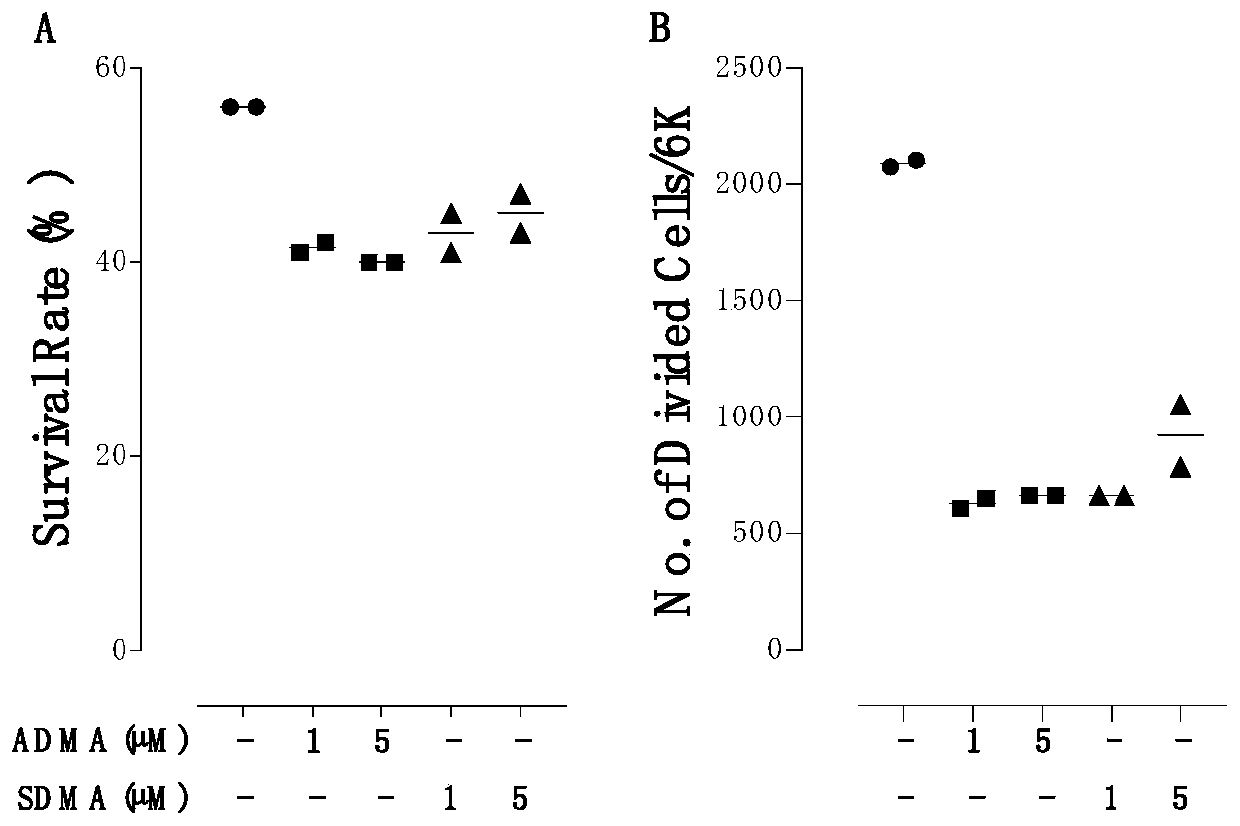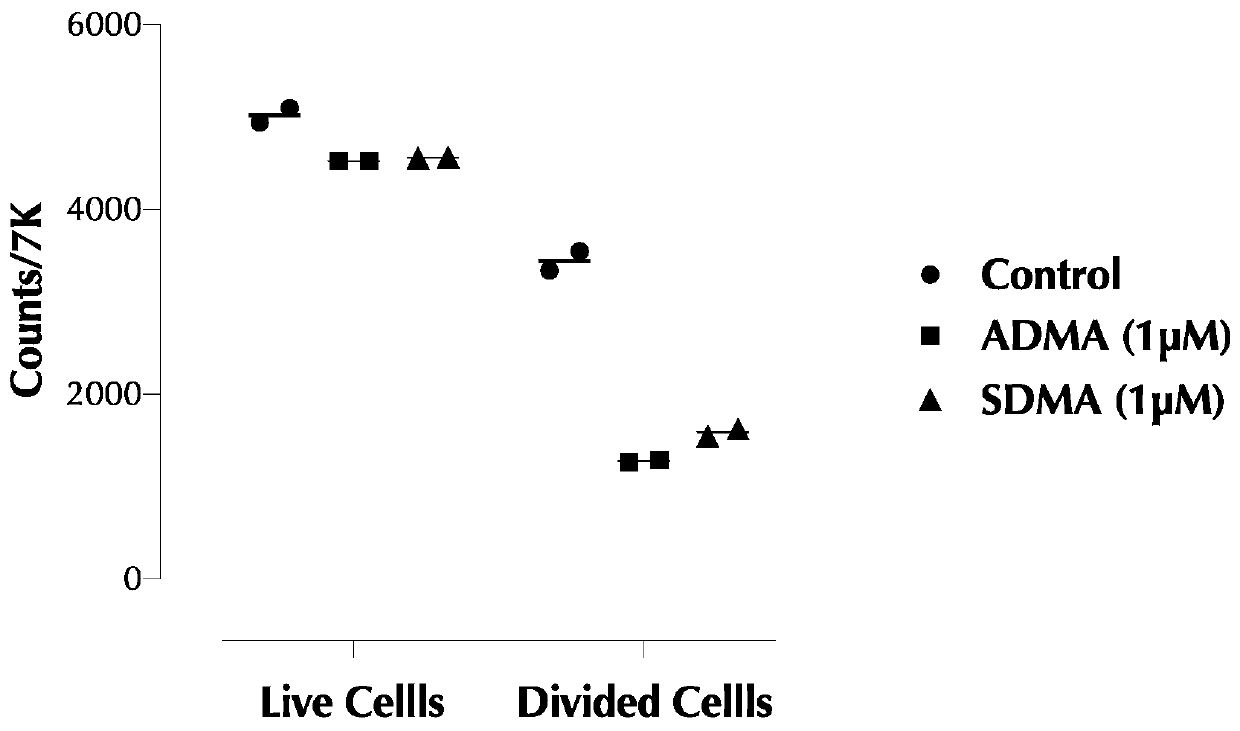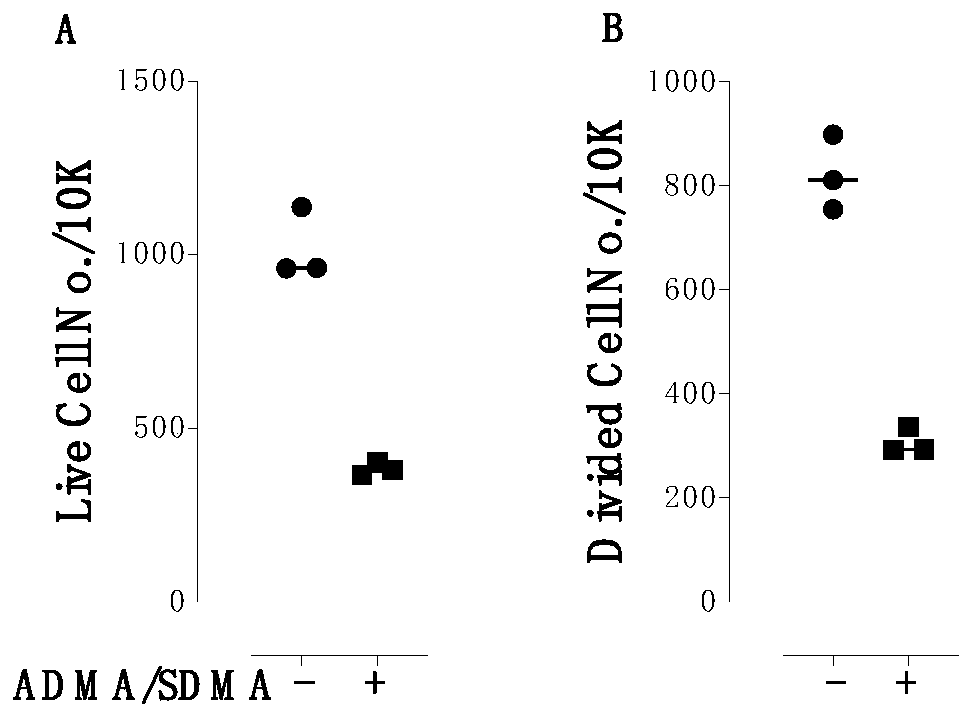Application of dimethylarginine and derivatives thereof in inhibition of T and B cell proliferation
A technology of dimethylarginine and derivatives, which is applied in the field of dimethylarginine and its derivatives to inhibit the proliferation of T and B cells, can solve the problem of less research and achieve the effect of inhibiting the proliferation of T cells
- Summary
- Abstract
- Description
- Claims
- Application Information
AI Technical Summary
Problems solved by technology
Method used
Image
Examples
Embodiment 1
[0041] Example 1 ADMA and SDMA inhibit the proliferation of mouse T cells
[0042] 1. Isolation of mouse T cells
[0043] Total splenic T cells were isolated with Stemcell cell isolation kit.
[0044] Take female 6-8 week old C57BL mice, crush the spleen, wash with biotin-linked antibody solution (including anti-B220, CD11B, CD11c, CD16 / 32, CD19, CD25, CD105, NK1.1 and TCRγδ) and add Streptavidin-coated magnetic beads, followed by a magnetic field, CD3 + T cells are enriched in suspension.
[0045] 2. Inhibitory effect of ADMA and SDMA on mouse T cell proliferation
[0046] The total T cells obtained in step 1 were stained with CellTrace and labeled with 2 × 10 5 Each well was seeded in a 96-well round-bottom cell culture plate and stimulated with anti-CD3 and CD28-coated magnetic beads (using Gibco Dynabeads mouse T-activator CD3 / CD28 for T-cell expansion and activation). The number of magnetic beads: the number of cells was 1:4. Experimental group: Add different concen...
Embodiment 2
[0048] Example 2 ADMA and SDMA inhibit the proliferation of human T cells
[0049] Isolation and in vitro proliferation experiments of human T cells: The use of peripheral blood from healthy adults was approved by the Ethics Committee of Guangzhou Medical University. Peripheral blood mononuclear cells were isolated by Sepmate peripheral blood mononuclear cell separation tube, and CD3 + Human T cell isolation kit (Miltenyi) was used to isolate human T cells. The isolated T cells were collected at a density of 1 × 10 5 Seed in a 96-well round-bottom cell plate coated with anti-human CD3 (5μg / ml) and CD28 (2μg / ml) per well. Experimental group: Add different concentrations of ADMA and SDMA respectively (ADMA and SDMA were dissolved in sterile Endotoxin-free water, stock solution concentration 0.5mM), control group: add the same volume of sterile endotoxin-free water. Cell proliferation was analyzed by flow cytometry after 4 days of culture in RPMI-1640 medium.
[0050] The exp...
Embodiment 3
[0051] Example 3 ADMA and SDMA inhibit the proliferation of mouse B cells
[0052] Isolation of total splenocytes: Mice were killed by cervical dislocation, the spleen was isolated, and the spleen was placed on a 100 μm cell mesh at the mouth of a 50 ml cytocentrifuge tube moistened with sterile endotoxin-free PBS, using a 1 ml sterile syringe The spleen tissue was crushed at the end of the piston core rod, and the cell suspension in a 50 ml tube was collected, centrifuged at 500 rcf for 5 min and resuspended in RPMI 1640 complete medium (10% FBS).
[0053] In vitro proliferation of mouse B cells: total splenocytes were isolated from mice and stained with CellTrace labeling at 5 × 10 5 Each well was seeded in a 96-well round-bottom cell culture plate with anti-IgM (10 μg / ml) and human recombinant IL-4 (10 ng / ml) to stimulate B cell proliferation. Experimental group: ADMA and SDMA (ADMA and SDMA) were added with different concentrations, respectively. SDMA was dissolved in ste...
PUM
 Login to View More
Login to View More Abstract
Description
Claims
Application Information
 Login to View More
Login to View More - R&D Engineer
- R&D Manager
- IP Professional
- Industry Leading Data Capabilities
- Powerful AI technology
- Patent DNA Extraction
Browse by: Latest US Patents, China's latest patents, Technical Efficacy Thesaurus, Application Domain, Technology Topic, Popular Technical Reports.
© 2024 PatSnap. All rights reserved.Legal|Privacy policy|Modern Slavery Act Transparency Statement|Sitemap|About US| Contact US: help@patsnap.com










